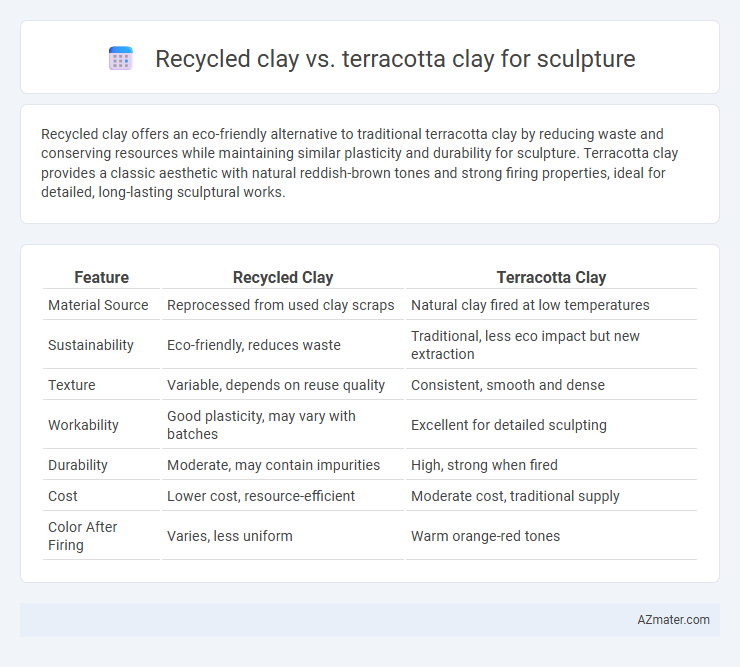Recycled clay offers an eco-friendly alternative to traditional terracotta clay by reducing waste and conserving resources while maintaining similar plasticity and durability for sculpture. Terracotta clay provides a classic aesthetic with natural reddish-brown tones and strong firing properties, ideal for detailed, long-lasting sculptural works.
Table of Comparison
| Feature | Recycled Clay | Terracotta Clay |
|---|---|---|
| Material Source | Reprocessed from used clay scraps | Natural clay fired at low temperatures |
| Sustainability | Eco-friendly, reduces waste | Traditional, less eco impact but new extraction |
| Texture | Variable, depends on reuse quality | Consistent, smooth and dense |
| Workability | Good plasticity, may vary with batches | Excellent for detailed sculpting |
| Durability | Moderate, may contain impurities | High, strong when fired |
| Cost | Lower cost, resource-efficient | Moderate cost, traditional supply |
| Color After Firing | Varies, less uniform | Warm orange-red tones |
Introduction to Recycled Clay and Terracotta Clay
Recycled clay is made by reprocessing used or discarded clay material, offering an eco-friendly option that conserves natural resources while maintaining plasticity suitable for various sculptural techniques. Terracotta clay, a traditional earthenware material known for its rich iron oxide content, produces a warm, reddish-brown hue after firing, and excels in durability and weather resistance for outdoor sculptures. Both clays offer unique textural qualities and versatility, with recycled clay promoting sustainability and terracotta providing classic aesthetic appeal in sculptural art.
Material Composition and Sources
Recycled clay consists primarily of previously used ceramic materials combined with fresh clay, reducing waste and environmental impact by repurposing scraps from pottery production. Terracotta clay is a naturally occurring, porous earthenware material rich in iron oxide, which gives it its characteristic reddish-brown color and is sourced from specific clay deposits known for their mineral content. The material composition differences influence durability and texture, with recycled clay offering variable consistency depending on the mix, while terracotta provides a traditional, uniform medium favored for sculptural detail.
Environmental Impact and Sustainability
Recycled clay significantly reduces waste and conserves natural resources by reusing previously fired or unused clay materials, lowering the demand for new raw clay extraction. Terracotta clay, while traditional and widely used, often requires continuous mining, contributing to habitat disruption and resource depletion. Choosing recycled clay enhances environmental sustainability by minimizing landfill contributions and energy consumption associated with clay processing.
Workability and Sculpting Properties
Recycled clay often contains impurities and inconsistent particle sizes, which can affect its plasticity and reduce workability compared to terracotta clay, known for its smooth texture and uniform composition. Terracotta clay provides excellent sculpting properties, allowing for detailed carving and easier manipulation due to its fine particles and optimal moisture retention. While recycled clay is eco-friendly and cost-effective, terracotta clay remains the preferred choice for professional sculptors seeking precision and durability in their work.
Firing Temperatures and Techniques
Recycled clay typically has a lower firing temperature range, around 1,000degC to 1,150degC, making it compatible with low-fire techniques such as earthenware. Terracotta clay fires at slightly higher temperatures, usually between 1,100degC and 1,200degC, allowing for more durability and a characteristic reddish-orange finish due to its iron content. Choosing the appropriate firing technique is essential: recycled clay is often used with oxidation firing to preserve its texture, while terracotta benefits from oxidation or reduction atmospheres to enhance color depth and surface quality.
Durability and Longevity of Sculptures
Recycled clay often contains impurities and inconsistent composition, which can reduce the durability and longevity of sculptures compared to terracotta clay. Terracotta clay, known for its uniform mineral content and firing properties, produces sculptures with greater resistance to cracking, weathering, and erosion over time. Sculptors seeking long-lasting outdoor art traditionally prefer terracotta clay for its proven structural integrity and preservation in various environmental conditions.
Aesthetic Qualities and Finishes
Recycled clay offers a unique, speckled texture and color variation that adds rustic charm and character to sculptures, while terracotta clay provides a consistent, warm reddish-brown hue prized for its classic, earthy aesthetic. Finishes on recycled clay tend to be more porous and matte, allowing for natural patinas and organic aging effects, whereas terracotta clay often achieves smooth, glossy finishes through glazing, enhancing its rich color depth. Sculptors choose recycled clay for a raw, textured appeal and terracotta for refined, traditional surfaces that emphasize fine detail and durability.
Cost Comparison and Availability
Recycled clay offers a cost-effective alternative to terracotta clay, often priced 30-50% lower due to its use of repurposed materials, making it ideal for budget-conscious sculptors. Terracotta clay, while generally more expensive, boasts consistent quality and widespread availability in specialized art supply stores and pottery centers, ensuring reliability for detailed work. Availability of recycled clay can be limited by local recycling programs or specific studio offerings, whereas terracotta remains a staple material in most ceramic art markets.
Common Applications in Sculpture
Recycled clay is commonly used for experimental sculptures and educational projects due to its cost-effectiveness and eco-friendly properties, often favored in preliminary modeling or practice pieces. Terracotta clay, known for its durability and warm, earthy tone, is preferred in finished sculptures and traditional ceramic artworks, especially in architectural and garden sculptures. Both materials support detailed textures, but terracotta's firing process enhances strength, making it ideal for long-lasting outdoor installations.
Choosing the Right Clay for Your Project
Recycled clay offers an eco-friendly option by reusing previously fired or used material, making it ideal for practice sessions and experiments, although it may have inconsistent texture and strength. Terracotta clay, known for its rich iron content and warm reddish hue, delivers excellent plasticity and durability, perfect for detailed sculptures with a traditional aesthetic. Selecting the right clay depends on the project's purpose, desired finish, and structural requirements, with terracotta suited for lasting works and recycled clay for environmentally conscious or preliminary creations.

Infographic: Recycled clay vs Terracotta clay for Sculpture
 azmater.com
azmater.com